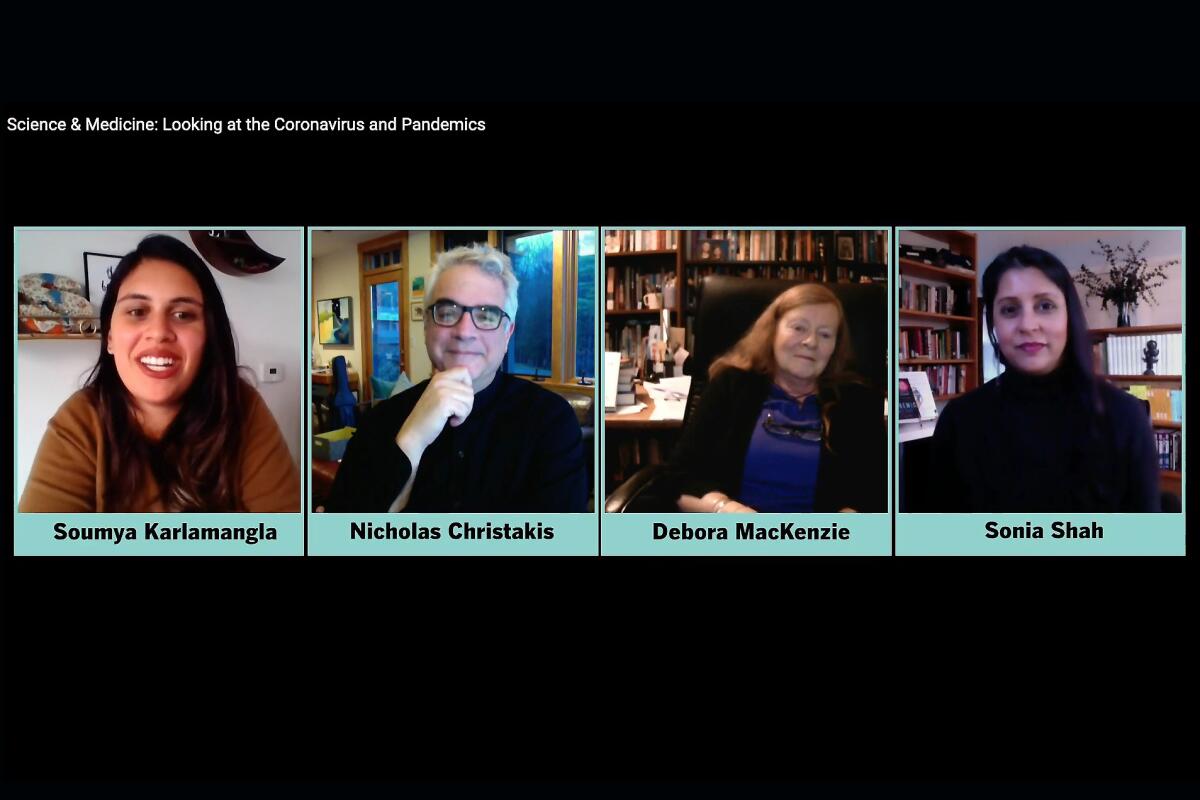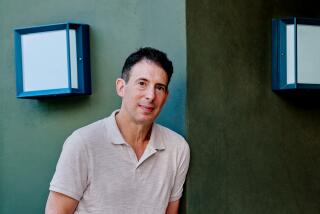As COVID-19 surges, science writers at the Festival of Books predict a long road ahead

- Share via
Festival of Books Roundup
Science and Medicine: Looking at the Coronavirus and Pandemics
With Debora MacKenzie, Nicholas Christakis, Sonia Shah and moderator Soumya Karlamangla.
If you buy books linked on our site, The Times may earn a commission from Bookshop.org, whose fees support independent bookstores.
“It will end with a whimper and not a bang,” said Sonia Shah, journalist and author of “Pandemic: Tracking Contagions, From Cholera to Ebola and Beyond.”
Shah was speaking at Friday’s science and medicine panel at the Los Angeles Times Festival of Books — the theme of which, naturally, was COVID-19. The panelists had been asked to make predictions on when we can be rid of a pandemic that has just this week surged to previously unimaginable levels, and Shah’s was the most optimistic scenario they could muster: a series of deescalating surges, mitigated by a slowly disseminated vaccine and perhaps some herd immunity.
Joining Shah on the virtual panel were Debora MacKenzie, author of “COVID-19: The Pandemic That Never Should Have Happened and How to Stop the Next One,” and physician and sociologist Nicholas Christakis, author of “Apollo’s Arrow: The Profound and Enduring Impact of Coronavirus on the Way We Live.” Times staff writer Soumya Karlamangla moderated.
MacKenzie predicted broad-scale vaccine distribution in 2021, going into 2022 — and she warned that no shot in the arm would be a magic bullet. “What I’m hearing from vaccine developers is the first vaccines are very unlikely to stop the virus from infecting people and then being passed on,” she said. In this scenario, “you’ve got enough immunity to defeat an infection if you get one, but you can still be infected, and you can still pass the virus on.”
This week’s all-virtual 2020 Festival of Books lineup features chats with USC professors and historians, Marilynne Robinson, Hector Tobar and more
In other words, not only are we deep in the woods, we won’t be out of them for a long time yet.
Christakis might have been tracking the virus the longest of the panelists. In January, colleagues in China asked him to track anonymous phone data via a tool previously used to monitor social movements for other kinds of studies. When he saw that China was setting up strict quarantines, he got a sense of what we might be in for.
“The Chinese felt that the adversary that they were facing in this virus required them to, in essence, detonate a social nuclear weapon,” Christakis said. “That’s how powerful they thought it was.”
They all agreed that the root cause of the pandemic was the displacement of animals, which brought them into closer proximity to human settlements; 70% of pathogens come from animals displaced from their habitat, according to Shaw. Christakis noted that measles was a cow disease until around 2,600 years ago, when domesticated cattle passed it along to their herders. Climate change should only accelerate the trend.
How does the Los Angeles Times coronavirus tracker work? The people who built and maintain it explain.
Scientists have known all this for a long time. Christakis said the U.S. should have acted as soon as it saw what he did in China. “Why weren’t we preparing,” Christakis asked. “Why weren’t we manufacturing [personal protective equipment], why weren’t we preparing testing capacity, why weren’t we manufacturing ventilators, why weren’t we — most importantly — preparing the American public for the sacrifice that would be required?”
MacKenzie suggested that it was never too late to take the pandemic seriously. She lives in France, which is in the midst of a new lockdown. “I can’t leave the house right now without a piece of paper saying why I’m outside the house,” she said. She suggested strict shutdowns followed by tracing of contacts.
There was only one problem with that, Christakis said. Contact tracing requires a level of containment; with 12% of Americans infected, it would have to be a massive, perhaps impossible undertaking. Public-health messaging on masks and distancing could still encourage a bending of even our current curve.
But even that messaging is weak. “The Trump administration has been appalling in this regard,” Christakis said. “Encouraging fantasies that the virus would disappear or that hydroxychloroquine would be an effective treatment. I mean, these things were known to be false.”
A season of disappointment and depression as COVID-19 rages
More to Read
Sign up for our Book Club newsletter
Get the latest news, events and more from the Los Angeles Times Book Club, and help us get L.A. reading and talking.
You may occasionally receive promotional content from the Los Angeles Times.











